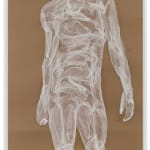Hazem Harb Palestinian-Italian, b. 1980
94 7/8 x 39 3/4 in
Literature
Rendered at life-size, Hazem Harb's self portrait hovers between presence and absence, encapsulating a sense of dislocation and personal vulnerability. The artist’s choice of material, gauze, is at once fragile and protective, evoking the tension between healing and pain and the notion of repair.
The word "gauze" holds a powerful resonance with collective histories, inseparable from the corporeal experience. Historically used in ancient and modern medicine for bodily envelopment, gauze signals the initiation of the act of repair. Serving as a visual announcement, it bears witness to injuries hidden from view. Known as "ــــــــــــــــــاﺷش" (shash) in Arabic, the English name "gauze" finds its etymological roots in the city of Gaza, Palestine, where the material has been historically crafted and from where Harb originates.
Hazem Harb's early connection with the material dates back to his childhood in Gaza in 2004, where he employed gauze as an artistic medium akin to canvas. Not originally intended for artistic purposes, gauze transformed into a creative outlet and an instrument of resistance for Harb amid the suffering of his people during his formative years.
Throughout Harb's artistic career, gauze has emerged as a recurrent resource. He utilised it for Burned Bodies, a video installation created during his art studies at Città dell'Altra Economia Roma in Italy in 2008.



